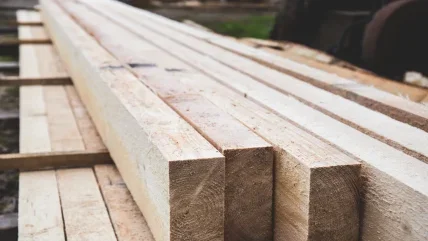
For our Focus on Italy Part One we turn to power technology company Turboden, a pioneer of biomass-fired Organic Rankine Cycle (ORC) technology.
The company, which has nearly 100 units in operation within the wood industries and hundreds more in other sectors, chose to exhibit in the panel production hall at Ligna this year for the first time.
A veteran of many Ligna exhibitions, Turboden decided to shift its stand to the panels technology hall as it seeks to build its profile in the sector. It has 10 units in operation within the primary panel manufacturing industry currently.
“The Ligna results have been good, it is always a very interesting exhibition,” said Alessandro Guercio, biomass sales and business development manager of Turboden.
“A lot of our prospects met with us. We were there to spread the knowledge of our solutions.
“In the past our interest was focused on standard applications in the wood industry where the heat was used for the drying process, such as drying lumber.
“Since about 2010 we also started to work in the wood panels sector with Kastamonu Entegre and we sold our first ORC to it in Turkey. We initiated a collaboration with it and have now delivered five plants.“
Mr Guercio said Turboden has some other references in the panels industry, describing the sector as having interesting potential.
Turboden, a Mitsubishi Heavy Industries Group Company, recently installed two ORC systems (13.6 MWe each) to Kastamonu Entegre.
Kastamonu already had three ORC plants supplied by Turboden, in Gebze and in Balikesir, for a total of five biomass plants and 30 MWe installed.
Turboden’s high-efficiency ORC turbines were installed in the factories in Balikesir and Kastamonu provinces, where electricity is being generated from wood and particleboard production wastes.
An ACC (air-cooled) model was installed in Balikesir, producing electricity while not requiring the use of water. The CO2 saving will be ca 30,000ton/year.
A co-generation ORC system, that produces both electricity and hot water, was delivered for the Kastamonu project.
In this case, the CO2 saving for electrical will be ca 30,000 ton/year and for thermal will be ca 62,000 ton/year.
Mr Guercio said Turboden is pushing a lot outside Turkey, looking to form relationships with all the big wood-based panel groups.
TURBODEN TECHNOLOGY
Turboden technologies can contribute to energy efficiency and decarbonisation in the wood-based panel production processes, starting with the biomass-fired ORC for combined heat and power (CHP) in particleboard and OSB production.
One of the primary characteristics of the Turboden solution is it does not use water as the working fluid, but organic fluids, such as siloxanes and cyclopentane instead.
Turboden ORC plants use any kind of biomass, from virgin wood to organic residues from various production processes. The generated power ranges up to 20MW electric and 80MW heat per single shift.
Turboden units can generate either hot water or higher temperature heat mediums (for example, saturated steam or thermal oil). Alternatively, Turboden can provide electric power only solutions.
In the 2000s, the industrial growth of Turboden was fuelled by its penetration into the untapped market segment of mediumsmall wood-based CHP power plants employed in the wood processing industry and in small district heating networks.
In these segments Turboden’s ORC technology offered the advantages of a completely automatic system, with very low O&M and competences to run it: such CHP systems can be employable also by sawmills and district heating networks that cannot afford to hire new people to run the CHP plants.
Typical applications include sawmills, panels factories, district heating and wood pellet production.
With specific regard to the panels sector, Mr Guercio outlined Turboden’s solutions to meet current requirements.
“There is a transition in the wood-based panels industry where production of particleboard and OSB is turning from the use of rotary drum dryers to belt dryers.
“It has opened a very interesting development to us because the belt dryer operates at about 100- 110OC and this fits very well with the ORC where we produce electricity but the residual heat can be delivered at a similar temperature.”
Mr Guercio said the belt dryer was becoming a real standard in the OSB and particleboard industry, with the ORC able to deliver all the heat for the belt dryer. Turboden says it has some compatibility with the MDF sector, having supplied an Austrian MDF producer in the past, but it highlighted the fact that higher temperatures were needed in the MDF production process.
The conventional ORC can deliver about 60% of the heat required for an MDF dryer – eg about 10-12MW of the 20MW required.
Turboden has been exploring a higher temperature ORC solution for such applications, with high temperature steam heat produced at the condenser. “We can produce steam at 12bar at the condenser which is the pressure needed at the refiner – the big consumer of heat in MDF production,” said Mr Guercio.
“But we can also feed the MDF dryer with an indirect heat exchanger and deliver steam at 190OC or 200OC which is good for the refiner and also for a heat exchanger, able to heat fresh air up to 180OC.”
The company is working with partners in order to offer a flexible solution to the MDF industry, as customers often decide on what boiler supplier they want. “We are fully compatible with every kind of boiler, so the customer can decide.”
The product has been developed with two experimental plants but fed by natural gas. Now Turboden is developing the solution with a biomass pellet boiler.
The technology does not use a conventional mineral or synthetic thermal oil as heat medium, it is a pressurised thermal oil that can operate at higher temperatures of +400OC.
But the company is not anticipating a big push on this at the moment because it is focusing on processing a large number of current project orders.
“It is a product that we will start to push again in the near future,” Mr Guercio said.
ENERGY TRENDS
The economic climate has been turbulent in the last few years, with price and availability of materials and energy changing quickly.
This volatility, acknowledges Turboden, makes it “diffuclt” to make forecasts for the future in terms of energy provision and prices.
The price of electricity was extremely high a year ago but that has now reduced. Natural gas from Russia was below €25/MW/ hr (before the Ukraine conflict). Natural gas prices sky-rocketed to hundreds of euros briefly a year ago.
“No-one knows for sure what will happen with the prices,” commented Mr Guercio.
“But my impression is that the price of natural gas will stabilise to an average of €80-90/MWh. If the price of energy remains as expected [in the €80/MWh region] many new investments on energy efficiency will become not only environmental friendly but also economically sustainable.”
One of the strongest marketing points for Turboden is how it can help insulate customers from energy price fluctuation.
“If you do not produce your own electricity you don’t know what the impact will be of the price of electricity bill in your production process in the short and medium terms. But if you install your CHP, producing your own electricity, you can control 50-70% of your electricity bill.
“We now have a range of products that cover different situations,” added Mr Guercio.
“We have the ORC, which is excellent to produce electricity from biomass waste. When the price of electricity is high, the ORC is an interesting solution. If the electricity price is low then the return of investment in the energy efficiency project will be longer.”
Turboden sees more electricity production in the future generally, pointing to the rise in alternative forms of energy such as solar, wind and biomass power.
The company also has large heat pump technology, which works in the opposite way to the ORC because it uses electricity to provide useful heat. The difference is that the ORC cycle works via producing electricity via rotation of a turbine, whereas with the heat pump a compressor replaces the turbine, generating heat through a thermodynamic cycle.
Mr Guercio points out that considerations for energy solutions need to also take into account the energy mix of the region where plants are located, the economics of the energy and also the environment.
Some Nordic ountries, such as Norway and Sweden, have a lower carbon footprint of the electricity production due to large use of eco-power. But there are also parts of the world where the opposite is true.
“We believe the market for the large heat pump will be very important in the mid-term for Turboden. So we follow the situation closely from the economic and environmental point of view.”
In biomass applications, hot gas can be used from the factory chimney to condense the vapour contained in the fumes into water, in this way extracting a lot of latent heat at low temperature, – to feed the heat pump. Electricity is used by heat pump to rise the temperature of this waste heat and producing hot water for belt dryers but also steam for MDF refiner. In this way a small amount of electricity can be converted in a big amount of useful heat. “Until a few years ago, I think the wood-based panels industry was only focused on raw materials and chemicals,” explained Mr Guercio. “But it’s also now a matter of energy.”
One of Turboden’s selling points is that the ORC is easy to operate, with no skilled operators required, unlike a conventional steam turbine.
“Implementing a CHP in the wood panel industry, especially with a belt dryer present, is something that is sustainable and economical. It reduces the carbon footprint if producing locally from biomass.
“Of course, it is not necessarily ideal to create 100% of your own electricity, but a good proportion in order to maximise the effectiveness of the resource. Using the residual heat from production processes makes sense.
“We look to dimension the solution starting from the thermal demand. So if you have a process with 30MW of heat demand for a belt dryer, then we dimension the ORC to produce 30MW heat and also ca 7MW of electricity.”
As well as the traditional composite panel sector, the plywood/LVL industry is also interesting to Turboden although but the heating demand of those products for the drying process is at a higher temperature, which is not compatible with the ORC’s production of heat.
“We can produce heat up to 130O-150OC but it is difficult to introduce heat at a lower temperature with the dryer.”
But Turboden has met with plywood makers and is looking at solutions.
“The main heat demand in the wood-based panels industry is the drying process, so if that process has the temperature compatible with the co-generation it is very interesting.
“This is why it is not convenient for biomass co-generation to heat a rotary dryer in particleboard production because the rotary dryer works at a very high temperature.”






